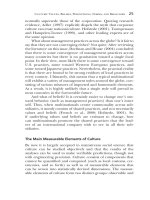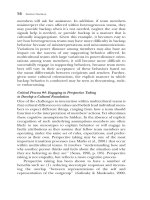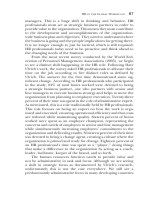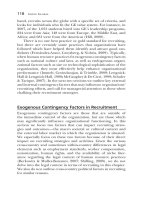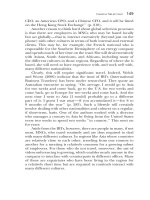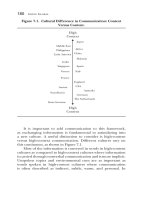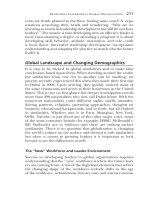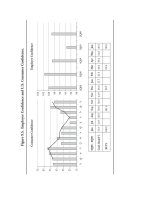Going Global Practical Applications and Recommendations for HR and OD Professionals in the Global Workplace J-B SIOP Professional Practice Series by Kyle Lundby, Jeffrey Jolton and Allen I. Kraut_9 doc
Bạn đang xem bản rút gọn của tài liệu. Xem và tải ngay bản đầy đủ của tài liệu tại đây (508.07 KB, 28 trang )
On-Boarding in a Global Workplace 187
Figure 7.2. (continued)
Systems
Office systems—computers, telephones, filing
Courtesies—protocol, etiquette
Hours of work, timesheets
Absence from work—annual leave, bank holidays, sickness
Communications
Meetings
Finance—expense claims, financial responsibilities
Policies and Personal Development
Training
Company policies (such as Development; Health and Wellness; Corporate
Social Responsibility, and so on)
Performance management process
Salary review guidelines
Performance Expectations
Ensure the employee’s line manager is available during the
employee’s initial arrival at the organization to clarify account-
abilities and establish priorities. This needs to be an ongo-
ing dialogue, but the line manager sets the stage on Day 1
for a successful relationship with the new employee. Sched-
ule a two-hour block of time for the line manager and new
employee to meet on Day 1. As Gallop’s research has shown, the
employee’s line manager plays the most important role in influ-
encing employee engagement and performance (Buckingham &
Coffman, 1999).
The line manager’s role in effectively establishing perfor-
mance expectations for the new hire includes the following:
• Provide an overview of the function’s role in the business and its
relationship to other functions
• Review the role description and agree on priorities and
timetables
188 Going Global
• Agree on how performance will be judged, who will be involved
in evaluating performance, and how performance will be
rewarded
• Define development goals
• Set up periodic informal evaluations
Some organizations highlight the critical role of the line
manager in effectively on-boarding new hires by including metrics
such as the percentage of time dedicated to on-boarding efforts
and turnover rates as part of line managers’ performance ratings.
3.Orientation
According to a survey by the Society for Human Resource Manage-
ment, 83% of companies report the use of a formal orientation
program for new employees. Unfortunately, the usefulness of
such programs from the perspective of the new employee varies
significantly. Some programs focus solely on communicating fac-
tual information about pay and benefits, company rules and
policies, and completing paperwork. Most of these activities can
be accomplished more efficiently and effectively with supporting
technology, allowing the employee to access the information when
necessary.
Table 7.4 highlights some of the common problems associated
with orientation programs from the perspective of new employees
(Werner & DeSimone, 2006).
Best practice companies approach new employees’ orientation
in very different ways. They design orientation programs that
concentrate on emotional takeaways and many identify a peer
coach or ‘‘buddy’’ to help orient the newcomer. The peer coach
is preferably the same level as the new employee and has tenure
of at least six months with the organization. In addition, the peer
coach should:
• Prepare a list of what he or she would have wanted to know
about the organization when he or she first entered
• Be available for 15 minutes per day during newcomer’s first
week
• Provide feedback and encouragement to the newcomer
• Provide guidance on expanding networks within the company
On-Boarding in a Global Workplace 189
Table 7.4. Common Problems with Orientation Sessions.
Problem Recommendation
Too much
paperwork
Most documents such as Personal Information,
Bank Details, Tax Forms, Medical Information, and
so on can be completed prior to the orientation.
Many organizations offer access to the company
intranet and provide clear guidance on information
required along with a contact person for questions
prior to the employee’s Day 1.
Information
overload
Don’t try to cram 20 hours of information into a
three-hour session. Newcomers generally lack the
ability to prioritize the information provided; focus
on critical pieces of information only.
Information
irrelevance
Consider your audience. Typically a wide variety of
employee skills and roles are represented in the
audience. Don’t spend time on details that are
irrelevant to your general audience.
Too much
selling of the
organization
The new employees have already ‘‘bought.’’ Build
on this fact.
Too much
one-way
communication
Take advantage of opportunity to allow new
employees to ask questions and to begin to build
networks. Building relationships with people in the
room is more important than any information
provided.
Lack of
follow-up
Ensure that information (including contact details
of attendees) from orientation is available
post-orientation. Provide a simple check-in with new
employees 30 days post-orientation.
• Serve as a sounding board and informal source of information
for questions related to policies, processes, work rules, and cor-
porate or local style and norms, for example.
In terms of more formal orientation sessions, best practice
companies use the time to describe the company’s history and
values and help employees feel connected to the company’s
190 Going Global
business strategy and financial goals. As Diana Oreck, vice pres-
ident of Ritz-Carlton’s Global Learning and Leadership Center
said, ‘‘People don’t remember what you said or what you did
but they always remember what they felt.’’ Southwest Airlines is
an example of another company that focuses its orientation pro-
gram on creating a positive emotional experience. The emotions
and feelings elicited in effective orientation programs include
welcome, comfort, security, pride, excitement, confidence. In
addition to sharing key information about the company (such
as history, values, strategy, organizational structure, and so on),
consider inviting respected employees and leaders to share client
success stories. These examples can give newcomers a sense of
accomplishment knowing they are working for a company that is
respected in the marketplace. In addition, stories relayed from
current employees and managers can help new employees begin
to visualize how they can help contribute to organizational success.
It is customary for orientation programs to be implemented
locally. In more advanced global organizations, common content
provided from the corporate group is incorporated into local
orientation sessions. Examples of this common content might
include a welcome message from the CEO, visions for future,
and high-level description of market results and strategic drivers.
Stories from senior leaders from around the world may be high-
lighted through videotaped messages. Depending on the level
and role and number of new employees, some organizations may
follow a local orientation with a global assimilation event (often
held at the company headquarters location). This kind of event
is designed to catalyze relationships with senior leaders and with
other new employees on a global scale and offers a nice transition
from the Accommodation stage of on-boarding to the final Role
Management stage.
Stage 3: Role Management
Building and managing relationships is the focus of the role man-
agement stage of on-boarding. This stage takes time, although the
combination of the right individual and efficient organizational
practices can accelerate the process. The value of establishing solid
On-Boarding in a Global Workplace 191
relationships with the employee’s new manager, direct reports,
peers, and other organizational members is well documented.
Research has consistently shown that people rely on other people
to get the information they need to get their jobs done (Cross,
2007). Newcomers are instantly at a disadvantage as they are on
the periphery of the web of relationships within the organization.
Organizational practices can facilitate and support newcomers to
build effective relationships with their manager, team, and larger
group of stakeholders.
Line Manager
The relationship with his manager is one of the most significant
in an employee’s career (Buckingham & Coffman, 1999). An
employee’s immediate manager is responsible for performance
management and career development processes, as well as provid-
ing ongoing coaching and feedback. Managers need to be involved
in every stage of the on-boarding experience, but some organi-
zations focus specific attention on ensuring that line managers
are skilled in working with new employees to establish objectives,
review progress, and provide constructive feedback designed to
facilitate the employee’s transition into the organization. Fur-
ther, the line manager plays an instrumental role in helping the
employee build important work relationships by providing appro-
priate introductions and, most important, in carefully considering
the first assignment for the new employee. Initial work projects
should require assistance from colleagues, especially those in dif-
ferent functions and departments. Avoid assigning initial projects
that involve working with external partners or suppliers. When
line managers review progress with the newcomer they should ask
not only ‘‘What have you accomplished?’’ but also ‘‘Who have you
established relationships with?’’
In global organizations, especially at senior levels, it is likely
that the newcomer’s immediate manager is not located in close
physical proximity. Managing virtual relationships has been
touched upon in other chapters (see for example, Chapters 1 and
4), but it is important to highlight here as well. New employees
who have remote managers need to assume 100% of the
responsibility for establishing and maintaining the relationship.
192 Going Global
Find a way to spend time together face-to-face, especially in
the early days. It’s recommended that the new employee’s line
manager travel to the newcomer’s location in the first week to
facilitate introductions and establish objectives. Also agree on
regular times and means for checking-in with each other; ideally
this will be weekly or biweekly during the initial transition period
and over the phone (not via e-mail).
Direct Reports
A process that has been used successfully at GE for years is focused
on relationships between the new employee and his or her direct
reports. GE refers to this as the New Manager Assimilation Process
and similar processes are used at many global companies including
Citigroup and Honeywell. A New Manager Assimilation Process
centers around three areas:
1. Relationship Management: setting the foundation by clarifying
roles, relationships of team, work climate, trust, and openness
2. Boundary Management: identifying critical priorities of the busi-
ness, understanding challenges and opportunities, and stake-
holders
3. Leadership Action: strategy structure, support, follow-up actions
of manager and team
The NMAP can take anywhere from a half day to one-and-a-
half days, and successful programs have a subsequent follow-up
session to check in and evaluate how things are going. The follow-
up normally takes place four to six months after the NMAP. In its
most basic form, data is collected from the new manager’s team,
summarized, and returned to the new manager who, together
with a coach, reviews the questions and prepares for a face-to-face
feedback session with the new team. Questions may include, but
do not need to be limited to, these examples:
• What do we already know about [New Manager]?
• What don’t we know but would like to know about [New
Manager]?
On-Boarding in a Global Workplace 193
• What are our concerns about [New Manager]?
• What do we want most from [New Manager]?
• What does [New Manager] need to know about us?
• What are the major challenges we face as business, function, or
team?
During the feedback session, the new manager responds to
the input and the questions gathered from the team. He or she
engages in dialogue with the team and agrees on actions. A sum-
mary of the feedback session is reviewed three to six months later.
The success of any New Manager Assimilation Process is depen-
dent upon an experienced, trained, and skilled facilitator. Prework
for these processes varies but may include an assessment of team
learning style and communication style, and could also include a
leadership style assessment for the new manager.
At Citigroup the NMAP was focused on the following
outcomes:
1. Enable a smooth transition for the new manager and the
manager’s team
2. Create a dedicated space for open dialogue and to share
information
3. Build relationships for effective work flow by clarifying infor-
mation and addressing misconceptions
4. Clarify vision and objectives through dialogue focused on shar-
ing, enhancing, and refining direction
5. Identify significant actions for the next six months
Generally the NMAPs are used for senior-level appointments
but an abbreviated version can be useful for employees at all
levels. This approach has been tested and used effectively in
Western cultures; see the following NMAP Process Example for an
explanation of the process at a major international gas company.
As indicated previously, it is important to apply techniques that
‘‘fit’’ into local cultures. A modified version of the NMAP where
information is provided to the new manager in written form, for
example, may be more effective in high-context cultures.
194 Going Global
NMAP Process Example
On-Boarding: Framework for Individual Support (12–18 Months)
• Stage I: Initial integration meeting
Takes place within first 30 days
• Stage 2: integration meeting (NMAP with team)
Takes place within first 90 days)
• Stage 3 integration meeting (Check-in)
Takes place within first 6 months
• Stage 4 integration meeting (Final check-in)
Takes place between 12 and 18 months
This work is coordinated and facilitated by a member of the
corporate executive development team working closely with the
local human resources manager and the new manger’s boss.
The work would include developing a formal integration plan,
arranging a mentor, liaising with the line manager, providing
360-degree feedback to the individual, and facilitating the inte-
gration with the team meeting. This corporate resource helps
the new manager navigate the internal landscape, network with
key stakeholders, quickly learn the internal ‘‘rules of the road’’
and is especially significant for those new managers that are
globally dispersed away from the corporate center. It is essential
for someone knowledgeable about the corporate center and the
key players to facilitate the on-boarding process. This process
greatly speeds up the new manager’s time-to-effectiveness.
Stakeholders
As more organizations realize the importance of social networks,
many are investing in a process of gathering stakeholder input
and mapping an initial network for the new employee. This
investment has resulted in reduced turnover and greater employee
engagement in diverse industries including financial services,
energy, technology, and health care.
Ideally the stakeholder input is gathered prior to the new
employee’s first day and focuses on four basic areas:
1. What are the expectations associated with role new leader is
stepping into?
On-Boarding in a Global Workplace 195
2. What challenges might the new leader face?
3. Insights and advice concerning our culture?
4. Who are the key people in the organization that this leader
must establish good relationships with?
A skilled transition coach, internal (ideally the HR member of
the on-boarding team) or external to the organization, facilitates
the process by attending to the details outlined in the following
Stakeholder Input Process.
Stakeholder Input Process: Transition Coach
Responsibilities
• Communicating the objectives of the process throughout the
organization, and specifically with hiring managers
• Ensuring support for the process from the hiring
manager
• Meeting with hiring manager to document his or her expecta-
tions associated with role, insight or advice regarding culture,
and gathering names of key stakeholders to participate in
process
• Working with line manager to craft invitation to stakeholders
to participate in a brief interview as part of assimilation of
new hire
• Interviewing key stakeholders
• Summarizing data, ensuring confidentiality of input
• Reviewing summary report with hiring manager and with new
employee
• Providing ongoing coaching and follow-up support to hiring
manager and new employee
Putting It All Together
We’ve discussed a number of elements that contribute to an
effective on-boarding process. Table 7.5 shows a time line of key
on-boarding activities starting from the time the new employee is
identified.
196 Going Global
Table 7.5. Putting It All Together.
When What Who
2–4 weeks prior
to start date
Prepare on-boarding plan Line manager
2–4 weeks prior
to start date
Organize on-boarding team (for
example, HR professional, peer
coach)
Line manager
2–4 weeks prior
to start date
Plan for move with service
providers
HR professional,
new hire
2–4 weeks prior
to start date
Schedule cultural assessment
and coaching
HR professional
2–4 weeks prior
to start date
Prepare post-offer acceptance
communication (including
internal or external
announcements)
HR professional,
line manager
2 weeks prior to
start date
Prepare announcement Line manager
2 weeks prior to
start date
Plan Stakeholder Analysis;
schedule and conduct interviews
HR professional
Day 1 Complete Day 1 Checklist HR professional or
peer coach
Day 1 New hire and line manager meet Line manager
Weeks 1–2 Arrange 1–1 meetings with team
members
Line manager, new
hire
Weeks 1–2 Arrange 1–1 meetings with peers
and role model leaders
Line manager, new
hire
Weeks 1–2 Review feedback report from
Stakeholder Analysis with line
manager
HR professional
Weeks 1–2 Review feedback report from
Stakeholder Analysis with new
employee
HR professional,
Line manager
Weeks 2–3 Manager and new hire complete
performance objectives,
development plan
Line manager
(continued overleaf )
On-Boarding in a Global Workplace 197
Table 7.5. (continued)
When What Who
Weeks 2–9 New Hire visits operations,
customer outlets, etc.
Line manager
Weeks 2–9 New Hire meets external
vendors, suppliers, customers
Line manager
Weeks 2–4 Complete NMAP: data input HR professional
Ongoing Schedule weekly or biweekly
check-in meetings with line
manager
New hire
Weeks 4–8 Complete NMAP: Team dialogue HR professional,
new hire
Weeks 16–24 Follow-up NMAP HR professional,
new hire
The Future of On-boarding
As indicated previously in this chapter, there is very little
information available regarding on-boarding practices in global
organizations. As the number of global organizations continues
to increase, and consequently the number of employees working
outside of their country of origin continues to increase, there
is clearly an adequate sample to investigate basic questions.
For example, what best practices exist regarding on-boarding
employees into global organizations? We’ve highlighted some
in this chapter, but mostly from our own experience base.
Compiling a comprehensive set of best practices, and lessons
learned, from employees who have been effectively on-boarded
into global organizations would be useful. In addition, it would
be important to understand the costs (such as financial, resource
commitment) associated with on-boarding practices.
It would be valuable for researchers to investigate the following
areas related to on-boarding:
1. What is the failure rate for new hires or employees who transfer
to a new location within global company; do failure rates differ
if newcomers enter in headquarters locations versus remote
198 Going Global
locations? What impact does an effective on-boarding process
have on this?
2. Can overall performance of global organizations be compared:
those that invest in on-boarding and those that do not?
3. What are the more long-term outcomes of on-boarding, such
as career progression, promotion?
4. Do employees who go through effective on-boarding processes
build more effective virtual teams? Do their teams score higher
on engagement indices that those employees who have not
gone through on-boarding?
Organizations that implement on-boarding practices such as
New Manager Assimilation Processes and Stakeholder Analyses
have a wealth of information within these data sets. For example,
stakeholder perceptions of the organization’s culture could be
analyzed and applied more broadly to other HR processes, includ-
ing organizational reviews, recruiting, and communication.
References
Aberdeen Group. (2006). Onboarding benchmark report: Technology drivers
help improve the new hire experience. Boston: Aberdeen Group.
Allen, D. G. (2006). Do organizational socialization tactics influence
newcomer embeddedness and turnover? Journal of Management,
32(2), 237–256.
Bauer, T. N., & Green, S. G. (1994). Effect of newcomer involvement in
work-related activities: A longitudinal study of socialization. Journal
of Applied Psychology, 79, 211–223.
Bossert, R. (2004). Transition coaching activities accelerates leadership success.
Chief Learning Officer on CLOmedia.com.
Bradt, G. B., & Vonnegut, M. (2009). Onboarding: How to get your employees
up to speed in half the time.NewYork:Wiley.
Bradt, G., Check, J. A., & Pedraza, J. (2006). The new leader’s 100-day action
plan. Hoboken, NJ: Wiley.
Buckley, P. J., & Ghauri, P. N. (2004). Globalisation, economic geography
and the strategy of multinational enterprises. Journal of International
Business Studies, 35(2), 81–98.
Buckingham, M., & Coffman, C. (1999). First, break all the rules.NewYork:
Simon & Schuster.
Ciampa, D., & Watkins, M. (1999). Right from the start: Taking charge in a
new leadership role. Boston: Harvard Business School Press.
On-Boarding in a Global Workplace 199
Corporate Leadership Council. (2006). Attracting and retaining critical
talent segments (Volume I), Washington, DC: Corporate Executive
Board.
Cross, R., & Prusak, A. (2002). The people who make organizations
go—or stop. Harvard Business Review, 80, 1–22.
Dai, G., & DeMeuse, K. P. (2007). A review of on-boarding research.
Korn/Ferry International.
Feldman, D. C. (1976). A contingency theory of socialization. Adminis-
trative Science Quarterly, 21, 433–452.
Frazee, V. (1998). Keeping your expats healthy. Workforce, November,
19–23.
Gabarro, J. J. (1987). The dynamics of taking charge.Boston:Harvard
Business School Press.
Global Relocation Trends. (1999). Survey Report. Windham Inter-
national, National Foreign Trade Council and Institute for
International Human Resources, p. 24 .
Hall, E. T. (1976). Beyond culture. New York: Doubleday
Lomax, S. (2001). Best practices for managers and expatriates.NewYork:
Wiley.
McCall, M. W., & Hollenbeck, G. P. (2002). Developing global executives.
Boston: Harvard Business School Press.
Miller, V. D. (1996). An experimental study of newcomers’ information
seeking behaviours during organizational entry. Communication
Studies, 47, 1–24.
Pomeroy, A. (2006). Better executive onboarding processes needed. HR
Magazine, 51(8), 16.
Rhinesmith, S. H. (1996). A manager’s guide to globalization.NewYork:
McGraw-Hill.
Scullion, H., and Collings, D. (Eds.) (2006) Global staffing.London:
Routledge.
Smith, D. M. (1989). Organizational socialization of physical therapists.
Physical Therapy, 69(4), 282–286.
Tichey, N. (1983). Managing strategic change: Technical, political and cultural
dynamics. New York: Wiley.
Van Maanen, J.,& Schein, E. H.(1979).Toward a theory of organizational
socialization. Organizational Dynamics, Summer, 19–36.
Watkins, M. (2003). The first 90 days. Boston: Harvard Business School
Press.
Werner, J. M., & DeSimone, R. L. (2006). Human resource development
(4th ed.). Mason, OH: South-Western Cengage Learning.
PART 3
Maximizing
Performance
in the Global
Workplace
CHAPTER 8
Developing Leadership
in Global Organizations
Tommy Weir
Gone are the days of preparing for a single-country career and
the days of being a one-country company, as employees and orga-
nizations now live in the troughs of globalization and are not
bound by geographic borders. Yet many companies still practice
a single approach to developing leaders, and many operate on
the assumption that ‘‘leading’’ is the same all over the world. It
is time to move beyond this ideal. This is a simplistic and risky
practice because it is does not contribute to maximizing the invest-
ment made in leadership development, nor does the single-source
approach result in the sought-after outcomes of employee engage-
ment, performance, and organizational success. This chapter will
aid organizations with understanding the implications of the con-
temporary practices of global leadership development and will
recommend what should be practiced when developing leaders
in global organizations, highlighting the importance of grafting
local identity with the global organization’s culture.
There is no escaping the fact that there is a global consistency
in ‘‘what’’ leadership is, as every company requires leaders to
help direct and fulfill its strategic vision. However, the confusion
comes in mistaking the ‘‘what’’ and ‘‘how’’ of leadership, as there
are vast differences in terms of styles of leadership, focus on task
versus consideration, charisma, and transformation in comparison
to tactical knowledge and strategy. To illustrate this point, think
203
204 Going Global
about your experiences of traveling abroad and drinking a Coca-
Cola (or if you have not traveled abroad perhaps, you have tasted
different international versions of Coke in the Coca-Cola museum
in Atlanta or at Epcot). Prior to such an experience, the immediate
assumption is that Coke is the same all over the world. But is it?
Consistently, the color of the liquid is dark caramel, it is best when
cold, it has similar ingredients, and the container is the same
trademark red color, but the taste varies greatly from one region
to another. The ‘‘what’’ of Coke is the same all over the world—a
soft drink to quench thirst, but ‘‘how’’ it tastes varies by region to
match the local needs. The same concept is true for leadership.
The four-component parts of leadership—the leader, the
follower(s), the interaction between the two, and the outcome or
goal—appear to be similar all over the world. As the parts appear
to be consistent, organizations attempt to import and export the
practice of developing leaders from one market to the next, yet
this actually falls short of the desired outcome. The problem in
this approach is that each of the four leadership components
varies from country to country.
The flavor of leading and leadership development should be
suitably adjusted to local tastes as well. For example, a universal
practice of effective leaders is to provide clarity and direction to
the followers. This principle (the what of leading) is global, but
how the leader gives direction should vary by region. During a
recent visit to one of the world’s leading edible oil companies
in an emerging market city, I was given the following advice on
directions to give my driver: ‘‘Tell the driver that we are located
across from the vacant field next to where the toy store used
to be.’’ This vague landmark-oriented set of directions was very
discomforting for me as I come from a developed city where
maps and GPS are commonplace. I was a bit nervous about these
directions when I got in the car but arrived at my destination safe
and sound, as these directions were very clear to the driver. When
leaders are giving directions, they need to take into consideration
the regional nuances and practices of the local population. Is the
region accustomed to using a map or landmarks? Is it detailed with
street names and numbers or visual and reliant on landmarks?
Do they rely on Google maps for directions and get detailed sets
of directions or simply process the journey one step at a time?
Developing Leadership in Global Organizations 205
Leaders need to understand this level of difference and translate
this everyday practice of moving from one location to another
into how they communicate expectations in the workplace. The
practical application is that leading requires an awareness and
understanding of the local nuances.
Using a simplified definition of leadership as ‘‘what and how
aleaderdoestoandforhisorherfollowerstoachieveacommon
goal,’’ at the highest level, one can say that the ideals of ‘‘what
leadership is’’ are universal but ‘‘how’’ one leads is not universal,
nor is the process of leader development. By treating leadership
development as though it is the same from one region to another,
even though it is not, how can organizations expect to fully realize
their desired ROI from their leadership development efforts,
something that globally accounts for a staggering multibillion-
dollar investment?
Thus, organizations are increasingly saying, ‘‘Why is so much
invested in developing leaders, yet we don’t have leaders?’’ The
short answer is that there needs to be a high degree of localization
when it comes to the practice of leader development. The long
answer, and the subject of this chapter, is that it requires (1) look-
ing at and understanding the history of leadership development
activities—this is the starting point for understanding why orga-
nizations employ the methods they use to develop their leaders;
(2) looking past the perceived similarities to discover the real
demographic insights and leveraging the innate societal develop-
ment levers; and (3) building a universal yet localized leadership
development model that maximizes the investment. This chapter
will conclude with a case study outlining what global leadership
development looks like in a regional market.
History of Leadership Development Activities
To understand why global leadership development activities are
not yielding the desired tangible result of more effective leaders,
let us consider this practical example. Recently, an emerging-
market multinational company based in Dubai invested $3 million
in a globally top-ranked executive education program to develop
a mere 150 high-potential leaders. The company’s hope was that
by selecting one of the leading executive education programs with
206 Going Global
several Fortune 100 clients, that they too would raise their level of
leadership effectiveness. This program imported the ‘‘best of the
best’’ business school faculty and covered topics such as strategy,
decision making, team building, emotional intelligence, finance,
marketing, and people skills. On paper, the program should have
been effective for this company.
Unfortunately, it was not—the results were less than stellar
and eventually the emerging-market multinational concluded that
they lost their investment, and cancelled the program. What would
cause a top-rated global executive education program to miss the
mark? Although there are many factors that make or break a
leadership development initiative and the impact that it may
have on an organization’s future success, what went wrong in
this program (and many others like it) is that it was heavily
steeped in Western thinking and approaches. In this instance,
the program was conducted with the underlying assumption that
there is a single approach to global leadership. In addition,
and perhaps what is most important, the faculty had limited
market understanding beyond an extensive literature review. What
was missing was an understanding of societal norms and local
practices that influence development. Would the results have
been different had the executive education program invested in
better equipping faculty with an understanding (ideally based on
real-life experience) of the local environment?
The reason that this program and many others like it are so
heavily influenced by the West is easy to understand when you
consider that:
• 18 of the top 20 executive education are in the West
• All but 5 of the top 100 MBA programs are in the West
• Nearly every one of the top-selling leadership books is written
by a Western author
Why has the West had such an influence on leadership train-
ing as a discipline? The apparent perception from the adopted
practices is that leadership development should come from the
West. This is a mistake, and this section explains why global orga-
nizations retain the overly simplistic thinking that ‘‘one leadership
model fits all’’ by walking through the modern history of what is
Developing Leadership in Global Organizations 207
practiced and understanding why. This is important to understand
in order to step back from the current practices and learn how to
improve developing leaders in global organizations.
Origins of Leadership Thought
The modern discipline of studying organizational leadership is
mono-cultural and has its genesis in the West with the leadership
trait studies. This was followed by Frederick Taylor’s ‘‘scientific
management’’ and by the Hawthorne Works of Western Electric
until the 1950s when the studies from the Big Ten schools of
Michigan and Ohio State from the heartland of America produced
their popular studies. When examining the various leadership
theories, it is important to keep in mind what was happening in
society and in the workforce at that time, as leadership research
is usually a response to the current environment. At that time,
the world was still reeling from the effects of the Second World
War and much of the thought about leadership and management
was shaped by a military mind-set. During this era and particularly
in a military situation, leaders were most interested in getting
subordinates to follow well-defined mandates. When leaders said
jump,thatiswhatwasexpected.Asaresult,leadershipactivity
was very mechanistic and top-down. In addition, organizations
where the studies took place were not at all concerned with global
issues. Today, being multinational is commonplace and in fact
highly sought after. Back then, however, the world was much less
connected.
It is also a practical reality that while researchers may accumu-
late knowledge over time, the foundation may remain intact. This
was the case with leadership where later practice built on preexist-
ing work, so the original insights and conclusions permeated later
thinking. In summary, the elements that created a foundation for
leadership thinking and practice included a basis in Anglo Saxon
model of traits, centralized control, hierarchical, and mechanistic.
Following the Second World War, the United States played
a major role in the world economy, and its industries, ideas,
and approaches dominated those of other countries—including
thinking about leadership. Since early work and modern leader-
ship research was U.S centric, Western ideals remain embedded
208 Going Global
in the core of leadership thinking and practices. Fast-forward to
modern day and this largely Western-driven approach is what is
being propagated around the world. And though it is effective in
many ways, it falls short in terms of preparing global leaders who
must operate in an increasingly interconnected world. In essence,
the field of play has changed but much of our thinking about
leadership has not.
Organizational Leadership Development Practices
The Industrial Revolution, which mainly transpired in the
West, helped usher in the concept of laboratory training as an
organizational practice for knowledge sharing where participants
learned from their own interactions and the evolving dynamics
of the group. From the likes of these basic skill training groups
(T-groups), the popularization of corporate training and learning
was born and eventually the creation of many forms of modern
leadership development, including individualized instruction,
development plans, on-the-job and coaching programs, inte-
grated performance support, 360-degree (multi-rater) feedback,
as well as online support. Like the rise of leadership theory and
research, leadership development activities were also Western
based. An example of three of the globally popular development
approaches will illustrate this: leadership centers, executive
education, and case studies.
Leadership Centers (Academy)
One of the first aggressive organizational leadership development
efforts started in the 1950s at GE’s famed Crotonville site. At that
time, GE was growing but realized they had a shortage of qualified
managers to run the additional divisions. GE first turned to local
universities to see if they could offer a solution to GE’s shortage
of qualified managers. Concluding that they could not help, GE
ultimately established their own internal leader maker center, and
began the concept of Leadership Centers (Academies). Over time,
the curriculum and approaches have been revamped to continue
to produce competent leaders but the concept as a whole has
remained more or less intact and true to its foundation.
Developing Leadership in Global Organizations 209
Not surprisingly, companies around the world have hopped
on the GE bandwagon, and hoping for similar results, imitated
the hugely successful practice for creating leaders, who are ‘‘cut
from the same cloth.’’ On the surface, this approach to leadership
development appears to have been successful.
The practical value of the Leadership Center (Academy)
is producing leaders who are modeled after others who have
proven to produce stellar results. The belief is that if an orga-
nization can reproduce its best leaders, then the organization
will have the bench strength to grow in the future and should
be able to grow faster and bigger. But is this true in the global
marketplace? Moreover, an approach that is focused more on
copying an existing leader archetype than evolving to what is
organic or unique to each culture would seem to be a suboptimal
strategy.
One of the pitfalls of such an approach is that it does not
consider the leaders’ backgrounds and how this differs from one
region to another. The practical recommendations for global
organizations section of this chapter outlines what should be
considered when developing leaders, and Leadership Center
approach will be stronger by integrating these considerations
on the leader level rather than just the organization level.
Executive Education
As other organizations became interested in the GE Leadership
Center approach, leading B-schools realized that they were losing
market share to internal corporate leadership programs and that
they needed to become more responsive to this new competi-
tive marketplace. Armed with top-quality faculty, these B-schools
realized that they could provide an important service to not only
degree-seeking students, but also nontraditional students through
public short courses, in-house programs for corporations, and
executive education programs. In essence, they were offering
business school education to those who either needed a refresher
or simply could not get away to pursue a formal degree program.
Their competitive advantage is their brand reputation, history,
and having the leading business thinkers as their faculty. The
assumption is that by learning from the best, you can become
210 Going Global
the best. During the past 20 years, these executive education pro-
grams have become widely popular all over the globe. The most
sought-after programs are from top-tier business schools in North
America and Western Europe.
However, on the global scene there is a significant pitfall as
witnessed in the Dubai-based organization. These programs do
not always travel well globally. Success in global leadership devel-
opment requires more than giving the program a passport and
clothing it in local culture. Increasingly, executive education pro-
grams are recognizing the need have a better understanding
of local culture, leader characteristics, and business environ-
ment in order to develop leaders who will succeed locally and
globally.
Case Studies
The Harvard Business School made a significant contribution
to the practice of developing leaders with the introduction of
their ‘‘Case Study’’ approach to growing leaders. Business case
studies recount real-life business situations in which leaders are
faced with a practical dilemma. By reviewing, discussing, and
critically analyzing the situation, students gain valuable insight
and thereby develop their own leadership capabilities. Harvard
adopted this practice out of necessity; there simply were not
adequate business textbooks to develop business executives. Over
the years, the case study approach has spread into training and
leadership development departments as a standard tool to help
grow organizational leaders.
Thevalueofthecasestudiesissignificant,astheycreatea
simulated environment allowing potential leaders to use real-life
situations. The pitfall, once again, is that they tend to use Western
examples and focus on Western business concerns. A common
request in the global marketplace is for the case studies to be
more relevant to their needs and concerns.
Each of these examples (leadership centers, executive educa-
tion, case studies) enjoys great success, and they have collectively
shaped the approaches that are used around the globe today to
train and develop our leaders. Although these approaches are
successful at home, they do not always resonate globally as their
Developing Leadership in Global Organizations 211
roots are firmly planted in the West, leaving some non-U.S. orga-
nizations scratching their heads and wondering, ‘‘Why are we
investing so much in leadership development but still do not have
leaders?’’ The answer is that developing into an effective leader is
more than attaining a degree or attending a program; it is about
developing skill, behavior, attitude, motivation, and role—with
a local flavor. Successful leadership development incorporates
understanding and adapting the practice to match who the future
leader is.
Global Landscape and Changing Demographics
It is easy to be tricked by global similarities and to make false
conclusions based upon them. When traveling around the world,
the similarities from one city to another can be startling; my
parents recently experienced this when they made their first trip
to Dubai in 2008. Upon arriving, they quickly noticed many of
the same restaurants and stores as their hometown in the United
States. This is true on first glance but deeper investigation reveals
more than 200 nationalities who now call Dubai home. With the
numerous nationalities come different sights, smells, attitudes,
driving patterns, religions, parenting approaches, thoughts on
business, educational backgrounds, and so forth, but all clothed
in similarities. Whether one is in Paris, Shanghai, New York,
Delhi, Nairobi, or just about any of the other major cities, many
of the same consumer brands (for example, HSBC, McDonald’s,
BP, Starbucks) are in evidence and there are striking surface
similarities. There is no question that globalization is changing
the world’s culture on the surface and dressed it with similarities
but when it comes to growing leaders it is important to look
beyond to see the differences as well.
The ‘‘New’’ Workforce and Leader Environment
Success in developing leaders in global organizations requires
understanding that the ‘‘new’’ workforce is where the future lead-
ers are coming from. A few of the high-level elements that reflect
the changing shape of the workforce include shifts in the age
of the workforce, urbanization, literacy rate, and microeconomic


